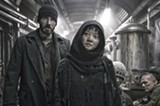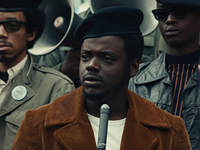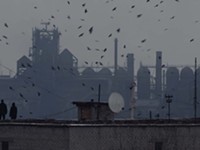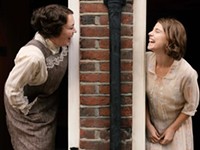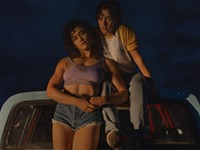[
{
"name": "500x250 Ad",
"insertPoint": "5",
"component": "15667920",
"parentWrapperClass": "",
"requiredCountToDisplay": "1"
}
]
The concept of the apocalypse and especially its aftermath never ceases to fascinate science fiction writers and filmmakers. Whether it comes with a bang or a whimper, the end of the world makes for exciting cinema, but the day after doomsday provides the most promising subject for literature and film.
Writers and directors employ a whole cornucopia of causes for the destruction of civilization; in our time such events as machines running amok, plagues, and catastrophic climate change replace that old favorite, global thermonuclear war. An environmental incident, outlined on the screen, creates the situation in "Snowpiercer"-- a substance released into the atmosphere generates a sudden immense drop in temperature all over the world, killing most of the population and returning the Earth to a new ice age.
A back story appearing late in the picture explains that one brilliant inventor, a railroad magnate named Wilford (Ed Harris) foresaw the crisis and constructed tracks and an enormous train that circled the globe, providing refuge for survivors. Despite the utter implausibility of the premise, the movie follows the long tradition of dystopian science fiction, dealing with the world established inside that train.
"Snowpiercer" opens that subject inside the carriages at the end of the train, dark, filthy, claustrophobic traveling hovels rather like the barracks of concentration camps, a resemblance emphasized by the presence of armed guards who brutalize the inhabitants and by a stern officer named Mason (Tilda Swinton), who speaks with a German accent. She spells out the social structure of the train -- first class passengers up front, economy class in the middle, and the group she calls freeloaders in something like steerage. The rigid class system is the brainchild of Wilford, who desires a world where people know their place and remain in it, because, somewhat tautologically, that's the way it should be.
One of the oppressed, Curtis (Chris Evans), leads a revolution, overpowering a contingent of guards, releasing a man who can open the many locks that separate the cars, and commanding his people in a series of bloody battles with the troops in Wilford's private army. As the group progresses through the train, wreaking destruction, they encounter the levels of social class constructed in conformity with Wilford's vision, moving through ascending strata of luxury and even decadence in their violent journey. In one of the most important moments they enter a schoolroom where the children accompany a filmed biography of Wilford's life with a hymn of praise and creepy stylized salutes.
When after a good deal of travail and several shootouts with a number of thugs, one of whom appears virtually immortal, Curtis finally meets Wilford, he learns some disturbing truths about the man, his vision, and his own place in the scheme of things. Wilford lectures him pleasantly on the meaning of the train as a kind of allegory and the reasons for some of the horrible history that Curtis has participated in and some of the inhuman actions he has witnessed. The philosophy Wilford espouses resembles the sort of social Darwinism, leavened with doses of Hobbes and Malthus, so popular among right-wing thinkers and business schools.
Though long and repetitive, like the train itself, "Snowpiercer" suggests it deserves a place among some of the classic works it draws upon -- novels like "Brave New World" and "1984," and films like Fritz Lang's great "Metropolis," which it copies and even in a sense updates. It also owes some debts to a wide and various array of post-apocalyptic dystopian movies, like "The Terminator," "The Road Warrior," and "Soylent Green."
The darkness and despair of the movie compensate for the essentially preposterous nature of its central premise. It alternates its frequent sequences of bloody violence -- one torture scene shows something entirely new in the history of that practice -- with a considerable amount of talky dialogue, some of it rather clumsily didactic. The director occasionally switches from all the claustrophobic interiors to long shots of the impossibly long train traversing bridges and plowing through snow drifts, deftly illuminating the class differences with gradually increasing lighting and a movement from a kind of chiaroscuroto soothing pastels. He suggests finally, however, that a dark future awaits us, speeding through an icy night.
Speaking of...
Latest in Movie Reviews
More by George Grella
-

Film Review: "Cake"
Jan 26, 2015 -
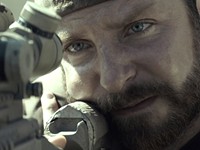
Film Review: "American Sniper"
Jan 19, 2015 -

Film Review: "Inherent Vice"
Jan 12, 2015 - More »
